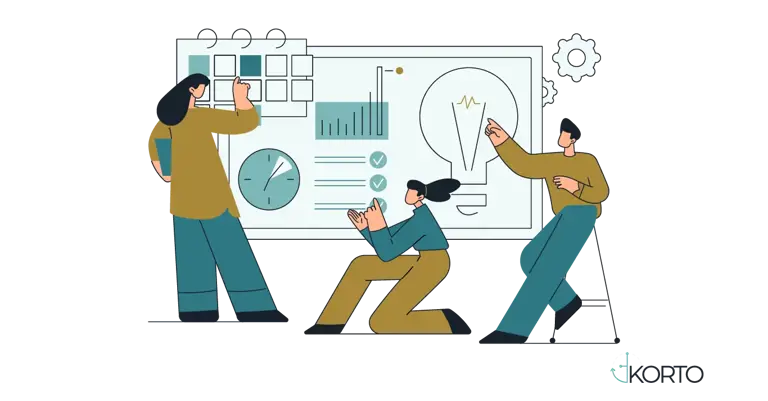How to organize employee files electronically?

Table of Contents
How to organize employee files electronically?
Ask any HR manager about their biggest headache, and they'll probably mention employee files.
Research shows 22% of employees waste half their workday searching for information. That's 20 hours per week per person - time that could be spent on actual work instead of digging through paperwork.
The employee file management market jumped from $1.8 billion in 2023 to a projected $3.5 billion by 2032. Companies are desperate for solutions, yet only 12% have fully digitized their employee files. The rest struggle with mixed systems that nobody can navigate properly.
Figuring out how to organize employee files electronically requires planning, consistency, and understanding what actually works in real offices with real deadlines. With data retention requirements by industry getting more complex and remote work demanding better access, companies that get this right will have a huge advantage.
Setting up folder structures
Most digital filing attempts fail because people treat electronic folders like virtual filing cabinets. They scan documents, dump them in folders, and six months later nobody can find anything.
Successful electronic filing starts with employee-specific folders as the foundation. HR teams think "Where's John Mayer's performance review?" not "Where did we file performance reviews?" This suggests organizing by employee first, then by document type.
For folder names, use formats like "12345 - Mayer, John" which sorts numerically by employee ID while staying readable. Avoid "Mayer, John" alone - you'll regret it when you hire another John Mayer.
Inside each employee folder, create standard subfolders that mirror how HR actually works: "Hiring," "Benefits," "Performance," "Medical," and "Payroll." Keep categories simple and intuitive. Someone new should understand the system without extensive training.
Larger companies might add department folders: "Sales > 12345 - Mayer, John > Benefits." Smaller organizations usually find this creates unnecessary complexity.
The critical rule is consistency everywhere. When different people file documents differently, the whole system breaks down fast. Document your structure and stick to it religiously.
Name your files properly
File names should include key information in predictable order: "Mayer_John_PerformanceReview_2025-03-15" tells you who, what, and when without opening the file.
Always use the date format YYYY-MM-DD so files sort chronologically. "2025-03-15" always comes before "2025-03-20," while "3-15-25" might sort incorrectly depending on the system.
For revised documents, add version numbers like "v1," "v2," or "FINAL" to prevent confusion. But don't go overboard - most documents shouldn't need more than two or three versions.
Avoid creative abbreviations and cute nicknames. "JS_PR_Q1" might be obvious when you create John Smith's quarterly performance review, but it's meaningless to everyone else.
Security basics for sensitive information
Employee files contain Social Security numbers, medical records, salary details, and disciplinary actions. Getting security wrong triggers lawsuits, fines, and reputation damage.
Start with role-based access control. HR generalists need broad access to most information. Managers should see only their direct reports' non-confidential data. Payroll staff need salary information, but shouldn't access medical records.
Medical information requires special handling under privacy laws. Store these documents in separate folders with extremely restricted access - typically limited to senior HR staff and benefits administrators.
Modern electronic document management systems offer sophisticated controls beyond basic read/write permissions. Advanced systems control who can view, edit, print, and share documents externally.
Audit trails log every interaction with employee files: who accessed what, when, and whether they made changes or downloads. These logs prove invaluable during investigations or compliance audits.
Regular access reviews should happen quarterly a minimum. People change roles, leave companies, or develop different access needs. Last year's permissions might be completely inappropriate today.
Legal compliance
Employment law creates retention requirements that vary by document type and jurisdiction. But the basics aren't complicated.
Federal regulations set baseline requirements: EEOC requires hiring records for one year, FLSA mandates payroll records for three years, and OSHA requires medical records for employment duration plus 30 years.
Data retention periods get complex when different rules apply to the same documents. I-9 forms need three years after hire or one year after termination, whichever is longer. Tax records typically require seven years.
State laws often exceed federal minimums, and multi-state employers must understand requirements everywhere they operate. The smart approach is to develop a comprehensive data retention policy covering every document type.
Electronic systems can automate much compliance work, but legal holds complicate normal retention when litigation becomes likely. Systems need mechanisms to preserve records beyond normal schedules until legal matters conclude.
Integration with financial systems
Employee records often serve HR and accounting simultaneously. Smart integration eliminates duplicate work while improving accuracy.
Salary information, tax withholdings, and benefits costs represent obvious areas where both teams need the same documents. Integrated systems store information once while providing appropriate access to both departments.
DMS systems in accounting and other markets organize information by fiscal periods and transaction types, while HR focuses on employee lifecycles. Modern platforms present the same data through multiple organizational approaches.
Automated synchronization prevents discrepancies when employee information changes. Salary adjustments, department transfers, and benefit elections are updated throughout the organization automatically.
Organize employee files with KORTO
Electronic employee file organization transforms HR efficiency while reducing compliance risks. But success requires platforms designed for HR workflows, not generic document storage.
KORTO provides comprehensive solutions built specifically for modern HR departments facing digital transformation challenges. Advanced security ensures privacy compliance while flexible integration connects with existing systems.
Professional implementation support ensures smooth transitions without operational disruption. Don't let inefficient file management continue to frustrate teams and limit organizational potential.
5-Second Summary
Managing employee records electronically is more than just scanning documents — it’s about building a structured, consistent, and secure system. By organizing files by employee, naming documents clearly, and controlling access, HR teams eliminate wasted time and compliance risks. Automated retention policies and legal considerations ensure your records meet all regulatory requirements. The result is faster workflows, fewer errors, and a system that scales as your company grows.
